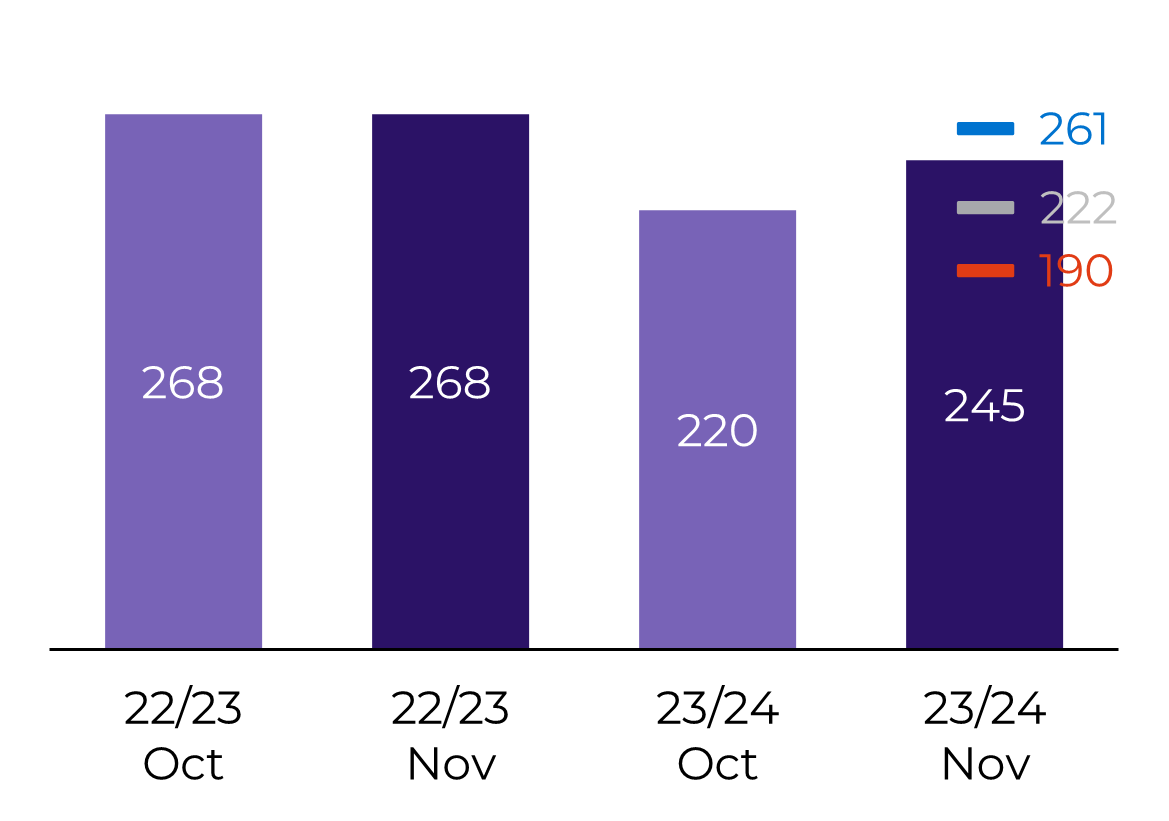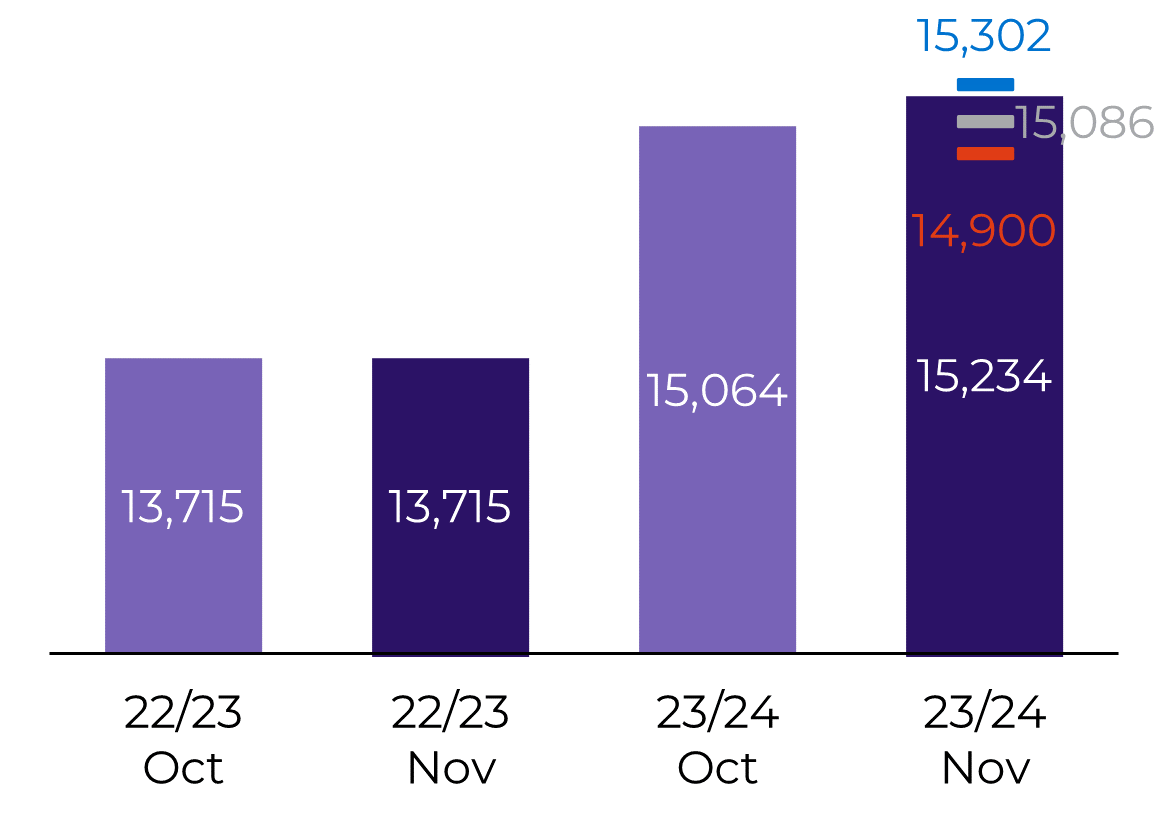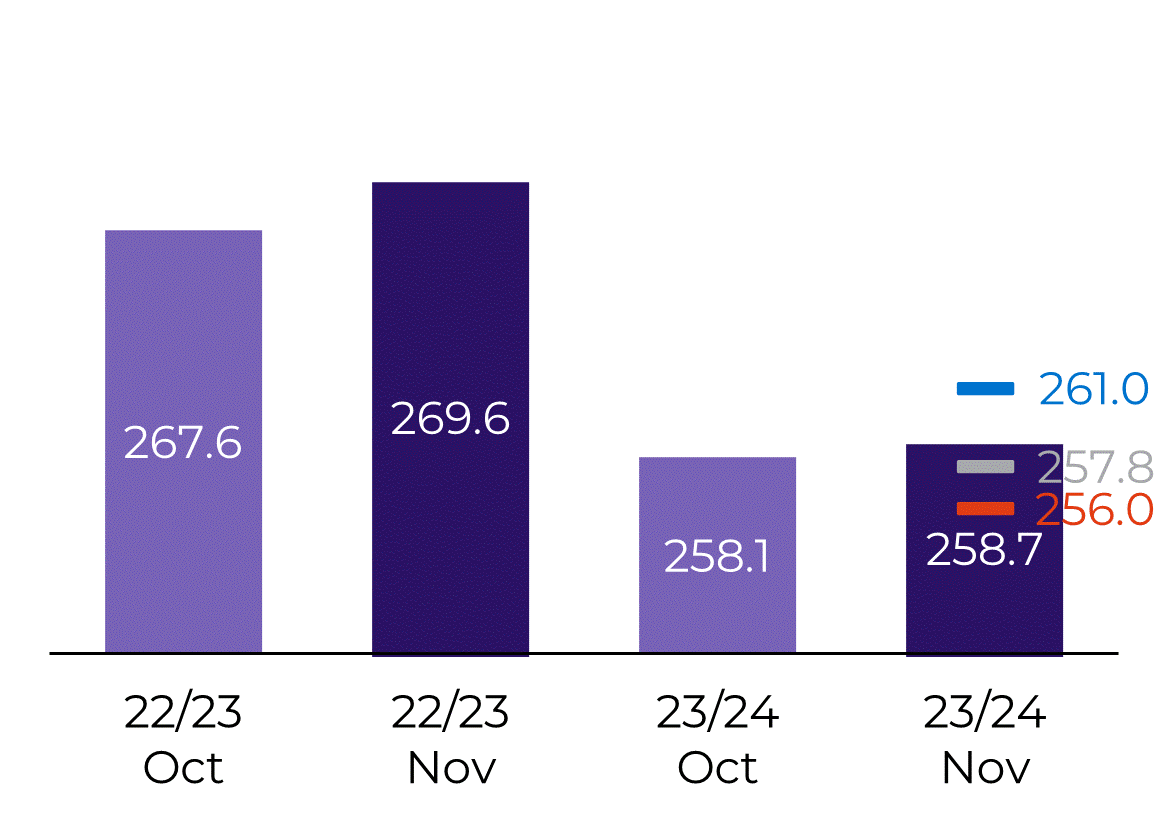
Nov 9
/
Alef Dias and Pedro Schicchi
Post-WASDE Monthly Report - 2023 11 09
Back to main blog page
"Results of the USDA's November report"
Soybeans:
Figure 1: US Soybean - Ending stocks (M bu)

The major change in soybeans’ balance was the increase in US production. Although the change was slight, it led to ending stocks close to the higher end of the expected range.
With the change, world production would reach 400M ton for the first time. South America was left untouched for the most part. As the prices have been rallying on Brazil’s poor weather, the market is likely to pay less attention to the USDA numbers during the next few months.
The bullish news came from China. With changes in the old crop (22/23) balance, the country’s carryover was reduced by 3M ton, leading to slightly lower world stocks.
Corn:
Figure 2: US Corn - Production (M bu)

On corn, USDA also increased production, which is now forecasted at a whopping 387M ton (15.2B bu), a record high for the country. In response, all demand lines were increased.
South America’s balances, once again, remained largely the same.
However, Ukraine’s production and exports were increased based on harvest results and the slightly higher flow seen in Odesa Ports since the establishment of the “Ukrainian corridor”.
The higher stocks in both the US and the Black Sea steered world stocks towards the higher end of the expected range - 315M ton, close to the highest estimate.
Wheat:
Figure 3: World Wheat - Ending Stocks (M ton)

On wheat’s side, Russia’s production increase was the biggest surprise of the report, bringing bearish pressure to wheat markets. Even though local consultancies were already pointing to a +90M mt crop, the lag in adjusting the 22/23 crop numbers made analysts skeptical of a severe adjustment in 23/24.
With an additional supply of 5M mt in Russia, the cuts to Argentine (-1.5M mt) and Indian (-2.95M mt) only offset the impact on world stocks, but didn't tighten it, as it was expected.
US’ ending stocks also came looser than expected, as exports were kept unchanged while imports were increased and food usage was reduced – July-September wheat used in milling was the smallest for the quarter since at least 2014.
Charts Legend

WASDE Commentary — Grains
Written by Alef Dias
alef.dias@hedgepointglobal.com
Written by Pedro Schicchi
pedro.schicchi@hedgepointglobal.com
alef.dias@hedgepointglobal.com
Written by Pedro Schicchi
pedro.schicchi@hedgepointglobal.com
Reviewed by Thaís Italiani
thais.italiani@hedgepointglobal.com
thais.italiani@hedgepointglobal.com
Disclaimer
This document has been prepared by hEDGEpoint Global Markets LLC and its affiliates ("HPGM") exclusively for informational and instructional purposes, without the purpose of creating obligations or commitments with third parties, and is not intended to promote an offer, or solicitation of an offer, to sell or buy any securities or investment products. HPGM and its associates expressly disclaim any use of the information contained herein that may result in direct or indirect damage of any kind. If you have any questions that are not resolved in the first instance of contact with the client (client.services@hedgepointglobal.com), please contact our internal ombudsman channel (ouvidoria@hedgepointglobal.com) or 0800-878-8408 (for clients in Brazil only).
Contact us
hedgepointhub.support@hedgepointglobal.com
ouvidoria@hedgepointglobal.com
Funchal Street, 418, 18º floor - Vila Olímpia São Paulo, SP, Brasil
This page has been prepared by Hedgepoint Schweiz AG and its affiliates (“Hedgepoint”) solely for informational and instructional purposes, without the purpose of instituting obligations or commitments to third parties, nor is it intended to promote an offer, or solicitation of an offer of sale or purchase relating to any securities, commodities interests or investment products. Hedgepoint and its associates expressly disclaim any use of the information contained herein that directly or indirectly result in damages or damages of any kind. Information is obtained from sources which we believe to be reliable, but we do not warrant or guarantee the timeliness or accuracy of this information. The trading of commodities interests such as futures, options, and swaps involves substantial risk of loss and may not be suitable for all investors. You should carefully consider wither such trading is suitable for you in light of your financial condition. Past performance is not necessarily indicative of future results. Customers should rely on their own independent judgement and/or advisors before entering in any transaction.Hedgepoint does not provide legal, tax or accounting advice and you are responsible for seeking any such advice separately.Hedgepoint Schweiz AG is organized, incorporated, and existing under the laws of Switzerland, is filiated to ARIF, the Association Romande des Intermédiaires Financiers, which is a FINMA-authorized Self-Regulatory Organization. Hedgepoint Commodities LLC is organized, incorporated, and existing under the laws of the USA, and is authorized and regulated by the Commodity Futures Trading Commission (CFTC) and a member of the National Futures Association (NFA) to act as an Introducing Broker and Commodity Trading Advisor. HedgePoint Global Markets Limited is Regulated by the Dubai Financial Services Authority. The content is directed at Professional Clients and not Retail Clients. Hedgepoint Global Markets PTE. Ltd is organized, incorporated, and existing under the laws of Singapore, exempted from obtaining a financial services license as per the Second Schedule of the Securities and Futures (Licensing and Conduct of Business) Act, by the Monetary Authority of Singapore (MAS). Hedgepoint Global Markets DTVM Ltda. is authorized and regulated in Brazil by the Central Bank of Brazil (BCB) and the Brazilian Securities Commission (CVM). Hedgepoint Serviços Ltda. is organized, incorporated, and existing under the laws of Brazil. Hedgepoint Global Markets S.A. is organized, incorporated, and existing under the laws of Uruguay. In case of questions not resolved by the first instance of customer contact (client.services@Hedgepointglobal.com), please contact internal ombudsman channel (ombudsman@hedgepointglobal.com – global or ouvidoria@hedgepointglobal.com – Brazil only) or call 0800-8788408 (Brazil only).Integrity, ethics, and transparency are values that guide our culture. To further strengthen our practices, Hedgepoint has a whistleblower channel for employees and third-parties by e-mail ethicline@hedgepointglobal.com or forms Ethic Line – Hedgepoint Global Markets.Security note: All contacts with customers and partners are conducted exclusively through our domain @hedgepointglobal.com. Do not accept any information, bills, statements or requests from different domains and pay special attention to any variations in letters or spelling, as they may indicate a fraudulent situation.“HedgePoint” and the “HedgePoint” logo are marks for the exclusive use of HedgePoint and/or its affiliates. Use or reproduction is prohibited, unless expressly authorized by HedgePoint. Furthermore, the use of any other marks in this document has been authorized for identification purposes only. It does not, therefore, imply any rights of HedgePoint in these marks or imply endorsement, association or seal by the owners of these marks with HedgePoint or its affiliates.

